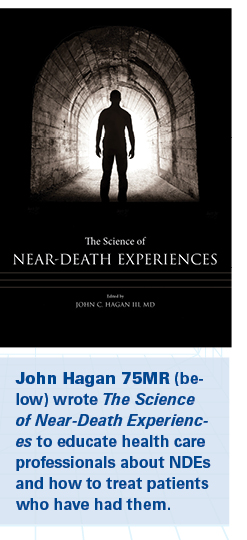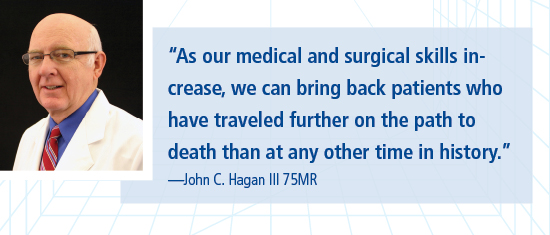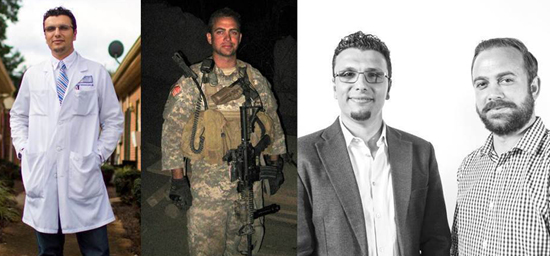News and views

Near-Death Experiences: A Doctor's Perspective
 |
|---|
Near-death experiences (NDEs) have received a lot of media attention lately, from television series (Proof), books (Embraced by the Light,) and movies (Heaven Is for Real) to recent accounts by physicians who have experienced NDEs: neurosurgeon Eben Alexander, while in a coma from meningitis, and orthopedic surgeon Mary Neal, after a near-drowning during kayaking.
But John C. Hagan III 75MR believes that many physicians and health care professionals aren't properly diagnosing and treating patients who have had NDEs.
Studies show that as many as 20% of people successfully resuscitated from cardiac arrest report a NDE when asked; estimates are that 10 million to 20 million people have had an NDE in the United States alone.
"Yet, few medical schools or residencies teach about near-death experiences in a structured way," says Hagan, an ex-Air Force officer and editor of Missouri Medicine journal who completed his residency in ophthalmology at Emory in 1975. "Rather than proactively encouraging patients to talk about their NDE with family and friends, and coming up with a positive, constructive plan for dealing with what many consider a life-changing event, physicians often do just the opposite, denying the NDE and discouraging any discussion."
Medical professionals can't verify the occurrence of NDEs through evidence-based scientific methodologies and tests, so they tend to dismiss them, Hagan says. "Physicians erroneously blame these transformative events on drug reactions, brain anoxia, alcohol withdrawal, or even mental illness," he says.
As a result, they may be hurting their patient's recovery. The patient should be encouraged to actively acknowledge these near-death moments as usually positive events that can favorably influence their future as a lodestar or guiding light, Hagan says. "Otherwise," he says, "the patient may require psychiatric or pharmacologic help to move on from an experience that he or she can't acknowledge."
In the face of a denying physician, a patient often does not verbalize and process what happened to them, fearing they will be rejected by the physician, loved ones, friends, and coworkers.
Hagan's interest in NDEs began six years ago when a friend loaned him a book about them that struck a resonant chord. A practicing ophthalmologist in Kansas City, Hagan has not had an NDE and does not consider himself an NDE "zealot." He did, however, see a huge, unmet need to teach all physicians about NDEs, and believes that a study of the phenomena may expand our knowledge of neurophysiology and the nature of consciousness.

He began gathering articles from doctors and researchers who could write about NDEs from a scientific perspective, which formed the basis of his recently released second book, The Science of Near-Death Experiences (Missouri University Press, 2017). "We used two criteria when recruiting authors," Hagan writes. "One, esteemed physicians or evidence-based researchers in the field of near-death experiences; two, physicians who themselves had a near-death experience. We preferred physician NDE accounts over non-physician accounts because physicians are trained to be objective observers. They have direct understanding of possible physiological interpretations, and their scientific background lends added credibility."
The book is intended to help medical profession recognize what NDEs are, how often they occur, and how to treat patients and their families as they deal with this significant event—"primarily through thoughtful questioning, sympathetic listening, validation of the experience, and referral to support groups," he says. "Physicians should be asking those patients: 'When you were unconscious and we were trying to resuscitate you, was there anything that happened that you want to talk about?' "
Mishandling these events can do damage to the patient physically and mentally, he says. On the other hand, if a health care provider responds appropriately, particularly with children, it helps them work through the experience in a positive way and aids healing.
Hagan is talking with three medical schools interested in addressing NDE education. "It wouldn't take much time away from the existing curriculum," he says. "An hour lecture would cover it and would add a great deal to patient care."
His book encourages readers to come to their own conclusion about the cause and significance of NDEs. Included, in fact, is a chapter by Kevin Nelson, a neurologist at the University of Kentucky, who believes that NDEs can be explained by distressed neurochemistry. But Hagan, as well as other experts in the book, believes the experiences are more complex than current technologies or scientific investigations can explain. "The recollections of those who say they've had an NDE often refute physicians' scientific explanation of how an oxygen-starved brain can produce such intense, vivid, and often corroborated veridical recollections," he says.
"How can all this happen when the brain is dead to this world?"—Lawrence Richter Quinn


Dr. Heval Kelli 15MR (above, left), an Atlanta doctor and Emory cardiology fellow who emigrated with his family from Syria as a child, and Garrett Cathcart (above, right), a West Point graduate and decorated U.S. Army vet, became friends when Kelli treated Cathcart at the Atlanta VA Medical Center.
Kelli and Cathcart believed that, like them, refugees and veterans would discover they have a lot in common if given a common space to talk. So they invited members of both groups to share a meal at the Clarkston Community Center one Sunday in early April. Communal tables held tabbouleh, lamb, hummus, and rice with cashews, and Syrian music was played as refugees and veterans practiced traditional circle dances.
"The Syrian refugees cooked a feast for the veterans," says Kelli, a cardiology fellow at Emory's School of Medicine who came to Clarkston with his Kurdish family in 2001 after escaping the violence in Syria.
Cathcart, a West Point graduate, U.S. Army veteran, and Bronze Star recipient for combat leadership in Iraq and Afghanistan, is pursuing his MBA at Goizueta Business School and is director of external relations for the Emory Veteran's Association. He met Kelli while being treated for kidney stones at the Atlanta VA Medical Center. "When you are in physical pain or someone that you love is hurting or sick, you don't really care where the doctor is from," Cathcart told the Atlanta Journal-Constitution. "You just want them to be good at their jobs."
Translators were on hand to foster communication. "It was a beautiful event on a Sunday afternoon," Kelli says. One girl drew a card for the event that read, "We are all Americans."






